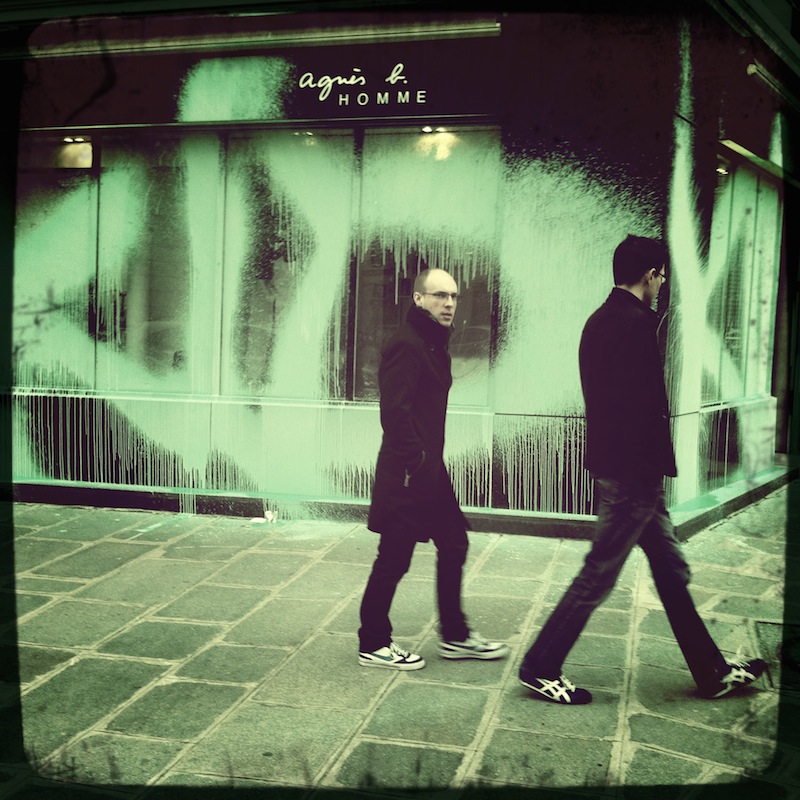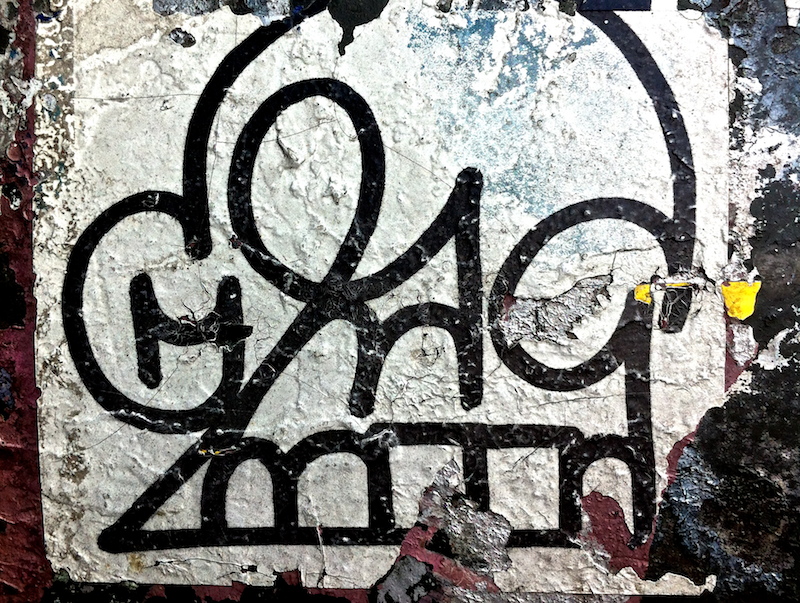Related to performing graffiti, there are at least two writers who have essentially used footage of their performances and expanded upon that to record video manifestos or video graffiti: KATSU and Kidult. Although both writers might seem similar to outsiders, they are actually quite different. KATSU, a member of the BTM crew, is a globally graffiti writer, undoubtedly a king. No one would question his legitimacy. Kidult, on the other hand, is someone whose work and character I have a love/hate relationship with. Whereas KATSU seems to just go out and do amazing graffiti, Kidult seems to have a Holden Caulfield-like obsession with corporate brands and authenticity. The whole thing leaves me with the suspicion that the person behind Kidult works as model or a designer for one of the brands that the character of Kidult so reviles and it has been suggested that perhaps Kidult gets hired by the brands he attacks as a form of guerrilla marketing. Whatever their motivations or differences, KATSU and Kidult have both been pushing graffiti forward and attracting online audiences in a similar way with their viral video manifestos. These videos are not just documentation of graffiti, they are video art or video graffiti, much like the zines that go beyond documentation of art and become artwork themselves.

Kidult’s work on the agnès b. homme store in Paris. Photo by totordenamur.
Kidult is best known for painting his name or other words on the outside of luxury fashion brands’ shops around the United States and Europe and using a fire extinguisher filled with paint to do the job. Although Kidult’s fire extinguisher pieces are difficult to miss if you happen to catch them before they get buffed, documenting the performance is an essential part of his practice. For one thing, most shops treat Kidult’s work like billboard companies treat ad disruptions and remove it as soon as possible, which is sort of Kidult’s point. The brands whose shops he hits are brands that have at times claimed to support graffiti culture, generally through clothing collaborations with graffiti writers. When the shops buff Kidult’s work, it is meant to show the brand’s hypocrisy for only supporting graffiti culture when they can co-opt and monetize it. At least, that seems to be Kidult’s point. He had said, “All these retail outlets have once used graffiti as a commercial tool to get more money and be ‘cool’ without knowing anything about the culture. I didn’t simply say ‘hello’ to them. If they really like graffiti, I just gave them what they love.” Some of Kidult’s videos are standard bombing videos, basically just proof that he did hit a store and that any photos aren’t just Photoshopped fakes, but other videos go further, bringing to mind Maismenos’ ± THE OILY LAND ± with their performance aspect as well as the random news clips interspersed throughout.
Frankly, a lot of Kidult’s videos are overproduced to the point where I’m not sure if if they are parody or not. One is actually a music video for a song by Prince 85 called Heaven. In Heaven, Kidult toss a molotov cocktail made in a champagne bottle, rides a motorcycle through the streets at night, wears his trademark skull bandana and a slick leather jacket, tags multiple stores, and walks around with his shoes on fire. The whole thing is kind of ridiculous, but it’s also a ready-to-go-viral introduction to Kidult. In the video, the actual pieces are less important than Kidult’s personality, his accessories, and the way he could not look any more ballsy when he walks up to a storefront and paints all over it. To a certain crowd, a crowd that would probably care less about his simpler videos or the pieces themselves, Kidult probably looks cool as fuck.
For Kidult’s 2011 video showing his tag on New York City’s Supreme store, there’s more footage of Kidult standing around looking cool, tagging a subway wall or spouting off vaguely revolutionary anti-art and anti-corporate platitudes in a distorted voice than footage of the actual piece on Supreme’s store. If videos like this one and Heaven are anything to go by, it seems that for Kidult, the piece is important and the performance is important, but the most important thing to get across is the persona behind it all. And why not? It’s an alluring persona even for someone not at all interested in graffiti, and there is a much larger audience around the world for interesting personalities than interesting graffiti.
The Supreme video included a lot of Kidult’s philosophy and character, but at the end of the day it was ostensibly about Kidult painting his piece on that store. With his videos Illegal World part I, Illegal World part II, and Visual Dictatorship, makes no real attempt to make it seem like the videos are about the vandalism. Yes, it’s there, but now Kidult hardly even pretends that it is the focus of the videos. In Visual Dictatorship, he starts with a series of video clips superimposed with corporate logos. It’s Kidult video art. Really, I think that’s what all his videos are: Video art that includes clips of Kidult doing graffiti, that’s what set them apart from typical graffiti videos.
Kidult’s videos, with the focus on a cool look and personality coupled with anti-establishment platitudes, seem to be designed to appeal to an audience who are buying the brands he is critiquing. Despite coming off corny at times, it’s an interesting strategy. What’s the point in hitting the store and posting a traditional video shot with a crappy camera if that’s only going to reach an audience who already agrees that brands like agnès b. and Supreme co-opt graffiti culture and should be avoided? Kidult has been interviewed by Highsnobiety and Hypebeast. He is trying to reach an audience of Supreme-wearing kids. He’s called his work propaganda, and it is. It’s propaganda designed to reach the people who buy products at the stores he is hitting. Most of that audience probably don’t take what he is doing to heart and just go buy another pair of Supreme-branded nunchucks, but maybe a few people who wouldn’t have otherwise seen his work are forced to reconsider their habits as consumers. Using video, Kidult has taken an extremely ephemeral and geographically precise act and made a product unrestricted by time or geography.

Sticker by KATSU. Photo by RJ Rushmore.
It should already be clear that KATSU is pretty spectacular and innovative both on the street and with his videos, and while I’ll get to what I think is his most groundbreaking video work in next chapter, there’s one more worth mentioning now: KATSU’s episode of Crack and Shine. Most episodes in the Crack and Shine series come from footage that Will Robson-Scott has taken on his adventures videoing and photographing some of the best graffiti talent around the world. But the KATSU video is different. In the credits, instead of having “A film by Will Robson-Scott,” what appears is “A film by Katsu.” It seems that Robson-Scott contacted KATSU about being in the Crack and Shine video series and KATSU responded by sending this video instead of having Robson-Scott follow him around.
The video is difficult to describe, but it’s something like a combination of advertisement, bombing video, propaganda and manifesto all rolled into one. With a distorted voice, KATSU explains who he is, what his crew (BTM) does, his views on graffiti’s relationship with art and society, his graffiti practice and his goals as a writer. In about three minutes, KATSU sums up what it means to be KATSU and what he has done in his graffiti career. While all this is going on, there are video clips of him tagging, putting up stickers, playing a violent video game, using his iPhone app and doing throw-ups, as well as photos of him writing graffiti, finished pieces, coverage of his work in major online publications, KATSU tattoos and other assorted graphics. Sometimes, bold text is overlaid onto the imagery to emphasis what KATSU is saying at the moment and there are flashing images of his skull logo throughout the video which seem like not-so-subliminal advertising along the lines of those HeadOn (apply directly to the forehead) advertisements.
Moreso than Kidult’s manifesto videos, KATSU’s manifesto video feels like a piece of graffiti. Okay, yes, the viewer chooses to watch the video and it’s not illegal like graffiti, but, particularly if the viewer is familiar with the previous Crack and Shine videos, he or she is definitely not expecting the sensory bombardment that KATSU delivers. And it’s not random that KATSU released this video through Crack and Shine (a series sponsored by Vans) instead of just releasing it on his own. The decision was yet another way to up his reputation and get his name out there. He says, “There’s many ways to credentialize a graffiti writer. One of those ways is to pair a graffiti writer name with a respected corporate brand. It has the ability to signify a certain degree of importance a specific graffiti writer has.” KATSU’s episode of Crack and Shine is one of the best in the series in terms of exploring graffiti culture, not because it is a great documentary about an impressive writer, but because it shows KATSU co-opting a brand that is attempting to co-opt him. KATSU used Vans’ resources to release an advertisement for himself.